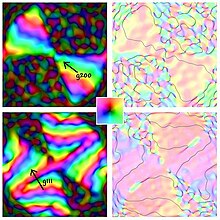
Crystallography is the experimental science of determining the arrangement of atoms in crystalline solids. Crystallography is a fundamental subject in the fields of materials science and solid-state physics. The word crystallography is derived from the Ancient Greek word κρύσταλλος, and γράφειν. In July 2012, the United Nations recognised the importance of the science of crystallography by proclaiming that 2014 the International Year of Crystallography.

A quasiperiodic crystal, or quasicrystal, is a structure that is ordered but not periodic. A quasicrystalline pattern can continuously fill all available space, but it lacks translational symmetry. While crystals, according to the classical crystallographic restriction theorem, can possess only two-, three-, four-, and six-fold rotational symmetries, the Bragg diffraction pattern of quasicrystals shows sharp peaks with other symmetry orders—for instance, five-fold.

In geometry, the pentagonal bipyramid is a polyhedron with 10 triangular faces. It is constructed by attaching two pentagonal pyramids to each of their bases. If the triangular faces are equilateral, the pentagonal bipyramid is an example of deltahedra, and of Johnson solid.

A nanoparticle or ultrafine particle is a particle of matter 1 to 100 nanometres (nm) in diameter. The term is sometimes used for larger particles, up to 500 nm, or fibers and tubes that are less than 100 nm in only two directions. At the lowest range, metal particles smaller than 1 nm are usually called atom clusters instead.
In condensed matter physics, the term geometrical frustration refers to a phenomenon where atoms tend to stick to non-trivial positions or where, on a regular crystal lattice, conflicting inter-atomic forces lead to quite complex structures. As a consequence of the frustration in the geometry or in the forces, a plenitude of distinct ground states may result at zero temperature, and usual thermal ordering may be suppressed at higher temperatures. Much studied examples are amorphous materials, glasses, or dilute magnets.

Crystal twinning occurs when two or more adjacent crystals of the same mineral are oriented so that they share some of the same crystal lattice points in a symmetrical manner. The result is an intergrowth of two separate crystals that are tightly bonded to each other. The surface along which the lattice points are shared in twinned crystals is called a composition surface or twin plane.
Gold clusters in cluster chemistry can be either discrete molecules or larger colloidal particles. Both types are described as nanoparticles, with diameters of less than one micrometer. A nanocluster is a collective group made up of a specific number of atoms or molecules held together by some interaction mechanism. Gold nanoclusters have potential applications in optoelectronics and catalysis.

Dan Shechtman is the Philip Tobias Professor of Materials Science at the Technion – Israel Institute of Technology, an Associate of the US Department of Energy's Ames National Laboratory, and Professor of Materials Science at Iowa State University. On April 8, 1982, while on sabbatical at the U.S. National Bureau of Standards in Washington, D.C., Shechtman discovered the icosahedral phase, which opened the new field of quasiperiodic crystals.
Complex metallic alloys (CMAs) or complex intermetallics (CIMs) are intermetallic compounds characterized by the following structural features:
- large unit cells, comprising some tens up to thousands of atoms,
- the presence of well-defined atom clusters, frequently of icosahedral point group symmetry,
- the occurrence of inherent disorder in the ideal structure.
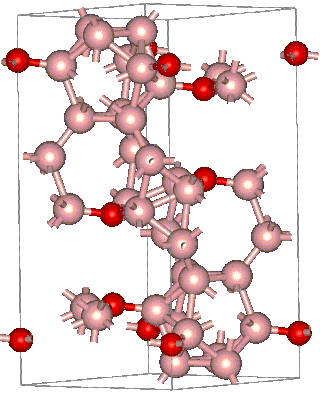
Boron suboxide (chemical formula B6O) is a solid compound with a structure built of eight icosahedra at the apexes of the rhombohedral unit cell. Each icosahedron is composed of twelve boron atoms. Two oxygen atoms are located in the interstices along the [111] rhombohedral direction. Due to its short interatomic bond lengths and strongly covalent character, B6O displays a range of outstanding physical and chemical properties such as great hardness (close to that of rhenium diboride and boron nitride), low mass density, high thermal conductivity, high chemical inertness, and excellent wear resistance.
In crystallography, a disclination is a line defect in which there is compensation of an angular gap. They were first discussed by Vito Volterra in 1907, who have an analysis of the elastic strains of a wedge disclination. By analogy to dislocations in crystals, the term, disinclination, was first used by Frederick Charles Frank and since then has been modified to its current usage, disclination. They have since been analyzed in some detail particularly by Roland deWit.
The hexatic phase is a state of matter that is between the solid and the isotropic liquid phases in two dimensional systems of particles. It is characterized by two order parameters: a short-range positional and a quasi-long-range orientational (sixfold) order. More generally, a hexatic is any phase that contains sixfold orientational order, in analogy with the nematic phase.
In physics, a phason is a form of collective excitation found in aperiodic crystal structures. Phasons are a type of quasiparticle: an emergent phenomenon of many-particle systems. Similar to phonons, phasons are quasiparticles associated with atomic motion. However, whereas phonons are related to the translation of atoms, phasons are associated with atomic rearrangement. As a result of this rearrangement, or modulation, the waves that describe the position of atoms in the crystal change phase -- hence the term "phason".
The Wulff construction is a method to determine the equilibrium shape of a droplet or crystal of fixed volume inside a separate phase. Energy minimization arguments are used to show that certain crystal planes are preferred over others, giving the crystal its shape.
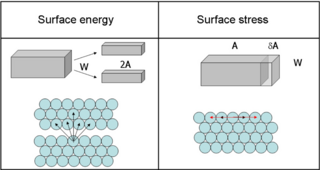
Surface stress was first defined by Josiah Willard Gibbs (1839–1903) as the amount of the reversible work per unit area needed to elastically stretch a pre-existing surface. Depending upon the convention used, the area is either the original, unstretched one which represents a constant number of atoms, or sometimes is the final area; these are atomistic versus continuum definitions. Some care is needed to ensure that the definition used is also consistent with the elastic strain energy, and misinterpretations and disagreements have occurred in the literature.

Yttrium boride refers to a crystalline material composed of different proportions of yttrium and boron, such as YB2, YB4, YB6, YB12, YB25, YB50 and YB66. They are all gray-colored, hard solids having high melting temperatures. The most common form is the yttrium hexaboride YB6. It exhibits superconductivity at relatively high temperature of 8.4 K and, similar to LaB6, is an electron cathode. Another remarkable yttrium boride is YB66. It has a large lattice constant (2.344 nm), high thermal and mechanical stability, and therefore is used as a diffraction grating for low-energy synchrotron radiation (1–2 keV).
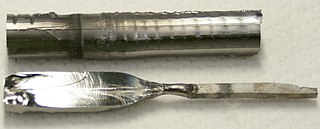
Metals, and specifically rare-earth elements, form numerous chemical complexes with boron. Their crystal structure and chemical bonding depend strongly on the metal element M and on its atomic ratio to boron. When B/M ratio exceeds 12, boron atoms form B12 icosahedra which are linked into a three-dimensional boron framework, and the metal atoms reside in the voids of this framework. Those icosahedra are basic structural units of most allotropes of boron and boron-rich rare-earth borides. In such borides, metal atoms donate electrons to the boron polyhedra, and thus these compounds are regarded as electron-deficient solids.
The KTHNY-theory describes the melting of crystals in two dimensions (2D). The name is derived from the initials of the surnames of John Michael Kosterlitz, David J. Thouless, Bertrand Halperin, David R. Nelson, and A. Peter Young, who developed the theory in the 1970s. It is, beside the Ising model in 2D and the XY model in 2D, one of the few theories, which can be solved analytically and which predicts a phase transition at a temperature .

Shape control in nanocrystal growth is the control of the shape of nanocrystals formed in their synthesis by means of varying reaction conditions. This is a concept studied in nanosciences, which is a part of both chemistry and condensed matter physics. There are two processes involved in the growth of these nanocrystals. Firstly, volume Gibbs free energy of the system containing the nanocrystal in solution decreases as the nanocrystal size increases. Secondly, each crystal has a surface Gibbs free energy that can be minimized by adopting the shape that is energetically most favorable. Surface energies of crystal planes are related to their Miller indices, which is why these can help predict the equilibrium shape of a certain nanocrystal.
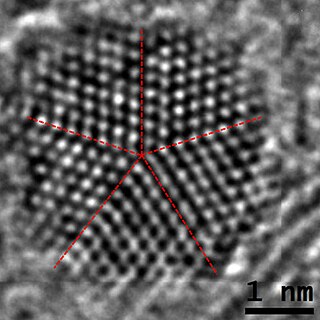
A fiveling, also known as a decahedral nanoparticle, a multiply-twinned particle (MTP), a pentagonal nanoparticle, a pentatwin, or a five-fold twin is a type of twinned crystal that can exist at sizes ranging from nanometers to millimetres. It contains five different single crystals arranged around a common axis. In most cases each unit has a face centered cubic (fcc) arrangement of the atoms, although they are also known for other types of crystal structure.



